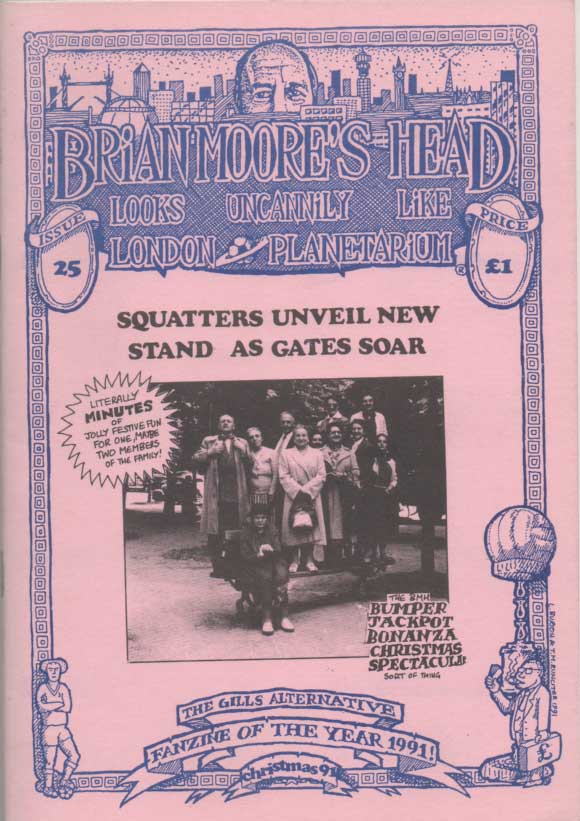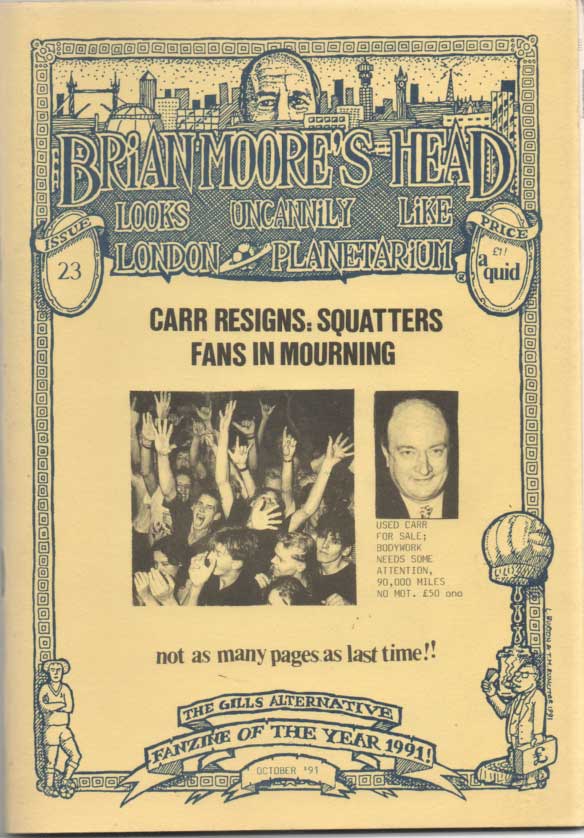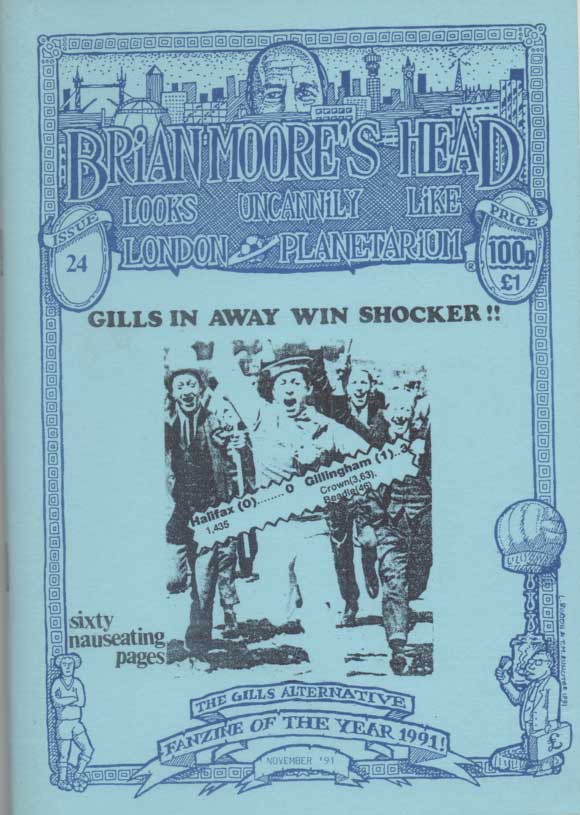Andy Ford delivers edition 11 of his fanzine series.
Issue twenty-three of Brian Moore’s Head was launched on 21 September 1991, at the home match against Football League newcomers Barnet, which ended 3-3. The editorial reflected on the Gills’ fairly decent start to the campaign and the poor opening suffered by our local rivals, Maidstone United, ‘Overall, the signs are extremely encouraging.
In all the games, excepting Scarborough, we have performed with both fluency and commitment, a blend which we have found difficult to produce since our return to the fourth division. The same cannot be said, however, for our friends over at Watling Street, who have had an absolute nightmare start to the season.
The resignation of (manager) Graham Carr, while coming as something of a surprise so early in the season, was an event that must have united the fans of both Gillingham and Maidstone for once, and I’m sure both sets of fans will join BMH in a resounding farewell raspberry to Mr Carr and his brand of so-called football.
It is my sincerest hope that no-one is stupid enough to ever give this man another job in football. There is no doubt that Carr has to carry the can for the current plight of the Maidstone team, for it is a side constructed in his image, it was he who sold off the talent and it was he who recruited the largest collection of mules seen outside of a donkey sanctuary.’
One feature, ‘London Calling’, illustrated with a large selection of photos, took up ten pages. It told of the day during the close season when four members of the BMH team tried to visit as many of the capital’s football stadia as possible. The task wasn’t on the scale of those who attempt to pass through all the stations on the London Underground station in a day, for which meticulous planning and a huge slice of luck is required, but we did have a loose itinerary, which did come apart at the seams during the afternoon.
The early nineties were a less security-minded era and we even managed to get inside a few of the grounds, as gates had been left open. First up was The Valley. Charlton had departed their home in 1985 and had subsequently been squatting, initially with Crystal Palace at Selhurst Park and then as West Ham’s tenants at Upton Park. The Addicks were due to return to their former home imminently, but that looked unlikely, judging by what we saw when we arrived, ‘We were staring at a rather large building site, which was supposed to be a football ground only a few weeks later. We thought that there was no chance that the piles of rubble and debris could be transformed into a ground fit to stage football matches by 14 September, the date the league had insisted that Charlton return to the Valley by.’ In the end, the club didn’t get back to playing at their old home until December 1992.
Millwall were still at the original Den and we got into the ground, which certainly looked a lot less menacing without any Lions fans inside. After a stroll around the Main Stand at Upton Park, the BMH quartet stopped off at West Ham’s club shop where Chris managed to get the programme from the Hammers match with Crewe the previous season, which he hadn’t been able to pick up on the day of the game (it was part of a £1 bargain bundle of programmes).

Then it was on to Orient, we wandered into Brisbane Road and watched the club’s youth team training for a while. Tottenham and Arsenal were next on the agenda and we couldn’t get into either White Hart Lane or Highbury. As time was getting on, the decision was taken to drop plans to visit Barnet, Watford and Brentford. We headed off to Queens Park Rangers, where another closed ground deflated the spirits further and, by the time we were back on the Tube, the evening rush hour was well underway, not a great time to be travelling.
The departure of Chris at that stage, who was on an early shift at work the following morning, coincided with an upturn in our fortunes, ‘We arrived at Stamford Bridge at just before 6pm. Building work on one of the stands at Stamford Bridge meant that the ground was open. We went in, half expecting chairman Ken Bates to pop out at any minute and either throw us out or charge us £9 terrace admission. There then followed a magical first for the three of us. It was the first time any of us had left the away terrace at Chelsea without being kept in for about forty minutes due to congestion on the Kings Road.’ We also got into Craven Cottage and, after Fulham, we headed for Plough Lane, former home of Wimbledon.
The Wombles had only left the ground at the end of the previous campaign, and posters were stuck up all over the place advertising the fact that the club would now be playing home matches at Crystal Palace’s Selhurst Park, which was our next and final stadium, number eleven of the day. We arrived at 8.55pm, it was just about dark and we didn’t hang around for too long before heading for home.
BMH 24 saw the fanzine back up to 60 pages, after issue 23 had been 56 pages. It included a letter advising how we could have been more successful with regard to our day visiting London grounds. In a meticulously detailed piece of correspondence, we were informed that we should have travelled around London by bicycle.
Our trip had been twelve hours and 38 minutes, but the writer stated that, with his timings, a trip by bike would have been slightly longer at exactly thirteen hours (‘pootling along at a leisurely 12mph’), but would have taken in three more grounds, Wembley, Barnet and Brentford. The response to the letter was, ‘We’re claiming victory until you get that bike round the grounds, and supply us with photos and an article to prove it! Anyway, we couldn’t go by bike, we haven’t got one big enough for four people... and thirteen hours in the saddle, we’re not Greg LeMond you know.’
In the same edition, the results of the ‘first (and quite probably the last) great BMH census were published. With seventy three returns received ‘from the length and breadth of this country and indeed others as well’ the fanzine felt ‘confident enough to draw sweeping conclusions on the nature of the readership of BMH and its habits.’ A massive 20% had been watching the Gills for over twenty years, with ‘Parents / Dad took me’ finishing top of the ‘Why did you start watching the Gills?’ category.
The one thing that would most improve Gillingham Football Club was promotion, followed by more money and decent players, with other responses in this section including ‘a Tube stop, preferably on the Piccadilly Line’ and ‘free admission from the unemployed’ from a BMH contributor who had just lost his job. Manchester United came out top in ‘What other teams do you follow?’, whilst Chelsea failed to appear in the top five responses. Other winners included Steve Lovell as favourite current Gills player, Gary Lineker, favourite current non-Gills player and Ian Botham as best sportsman.
Under favourite drink, bitter edged out lager to finish first, whilst tea came third. In a not totally unrelated category, ‘Most you have ever had to drink without being sick’, it was noted that ‘there seemed to be a large gulf between a group of people who had consumed an inordinately large amount of alcohol and those who retched at the sight of half a pint of shandy.’ A Tunbridge Wells reader had apparently once drunk four pints of Abbot ale and half a litre of vodka but claimed, ‘It was the humous, pitta bread and Duran Duran video that made me sick. And Tracey.’ The author of the census results article then wrote, ‘Having met Tracey, I can tell you she’d make a sober man sick.’
Thunderbirds was the favourite childrens’ television programme, ‘all the more impressive as the census was conducted before the programme’s long overdue return to television after an at least ten year absence in the TVS region’, whilst Diana, Princess of Wales, took ‘Favourite Royal’. The intelligence of the readership had to be questioned when 4% voted for chocolate in the ‘Favourite food apart from chocolate’ section and one person chose ‘apple’ as his favourite vegetable.
The well-run BMH operation was thrown into chaos just before Christmas. With plans for the season’s editions already set out, issue 25 was due to go on sale on Saturday 21 December, prior to the home game against York. It should have been delivered to the fanzine’s headquarters on the previous day, but failed to turn up. If it didn’t arrive on the day of the match we were looking at having to re-arrange the schedule and drop an issue. With no sign of the fanzines on the Saturday morning, it was left to the Mum of BMH co-editor Simon to hassle the delivery company, who were reneging on their promise to get the magazine to us. In the end, the new Head arrived in Rochester at around midday and went on sale, together with a free gift of a badge, less than two hours later. Despite the fact that the crowd at the match was only 2,700, we sold out of all the copies that we took with us to Priestfield that day.
In the autumn of 1991, Doncaster Rovers employed a no-segregation policy for our visit to Belle Vue. The article ‘I donny like it up north’ in BMH25 covered the match. The ground had a notorious huge fence in front of the away terrace and the BMH team were considering that a seat might be the best bet when ‘a copper told us we could go anywhere as there would be no segregation. More confusion – we wouldn’t commit ourselves until we knew where the rest of the Gills fans wanted to stand.

Hence we stood around like lost sheep, waiting for a border collie to come along and direct us into our allotted pen. In the end, we decided to stand in front of the Main Stand, mixing happily with the Donny fans. Desegregation seems to be on the way back, but it was weird and will take a bit of getting used to. Personally, I would have been happy enough for us all to use the away end with the fence removed, but presumably the reason that section is closed is that the fence is over the regulation height and it would be too costly to remove it. Nevertheless, the arrangement was perfectly reasonable with only 1,400 in the ground, but whether it will always work in different circumstances is another thing entirely, and the initial confusion did split up our vocal support.’
The other extreme in those days was to keep visiting fans in the ground for a while after matches whilst the home supporters made their way home. However, as BMH25 reported, a unique twist on this procedure was adopted, on one occasion, at the home of our local rivals. Under the heading ‘A Police request’, Dartford’s Superintendent of Police wrote the following message for the Stones’ fans, ‘I would like to thank the Maidstone United supporters for their impeccable behaviour thus far this season.
It has always been our policy to police your matches with as low profile as possible; in order to maintain safety for you, the supporters, in the ground. It is for the reason of safety that we intend to hold back the Maidstone supporters after the match against Burnley on 23 November 1991. This delay will be for approximately ten minutes until the Burnley supporters have vacated the ground. I know this will not be a popular decision and Bill Williams (Commercial Manager) and Chairman Jim Thompson have both requested us not to hold back home supporters. However, with 2,500+ Burnley supporters expected and an average home gate of only 1,000, it is clearly not safe to hold back 2,500 as 1,000.
This will not become common practice at Watling Street and is not intended as an insult to any supporters. We hope this will never occur when you get your new ground and wish you and your club well for the season.’
Kelvin Morton, who had the distinction of winning both worst and favourite referee categories in the BMH census, was featured in issue 25, following another glorious performance, this time in a 1-1 draw between Southend and Charlton at Roots Hall in October 1991, with one newspaper report including, ‘Southend boss David Webb and Charlton’s Alan Curbishley were tight-lipped about referee Kelvin Morton after a clash in which there were three sent off, four booked and three penalties.
Curbishley was the first to go, sent from the touchline after 35 minutes for apparently arguing with a linesman after Southend were awarded a penalty. Steve Gatting escaped with a booking for a professional foul but was next to go, after upending Ian Benjamin. Southend defender Spencer Prior was sent off for bringing down Garry Nelson for Charlton’s first penalty.’ Good to see that the legendary Kelvin was still providing entertainment.
